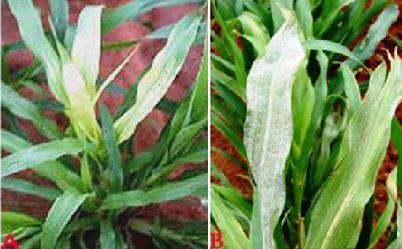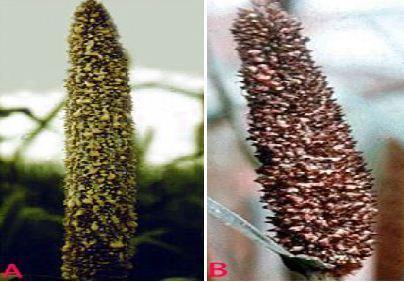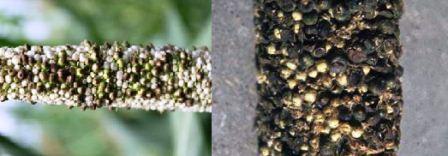Pearl millet : Diseases and Symptoms
Pearl millet : Diseases and Symptoms
Downy mildew
Damage symptom The characteristic symptoms of the disease are pale, chlorotic, broad streaks extending from base to tip of leaves.
The characteristic symptoms of the disease are pale, chlorotic, broad streaks extending from base to tip of leaves.- At the advancement of disease, the leaf streaks turn brown and the leaves become shredded longitudinally. In severe infection, the downy fungal growth can be seen on the upper as well as lower surface of the leaves.
- The rapid growth of fungal pathogen is favoured by rainy and humid environment. The infected plants fail to form ear but if formed, they are malformed to green leafy structures.
- The complete ear can be transformed into leafy structure.
- The fungal pathogen transformed all floral parts such as glumes, palea, stamens and pistils into green linear leafy structures of variable lengths.
- As the disease advances, the malformed floral structures of ears become brown and dry.
- The oospores remain viable for eight months to ten years or more in the soil, which makes primary infection in host plants and present abundantly in diseased leaves fall on the ground.
- The secondary spread of disease starts from sporangia, which are most active in moist environment.
- The atmospheric temperatures between 15-25 °C and relative humidity above 85 per cent.
- Light drizzling accompanied by cool weather is highly favourable
Ergot
Damage symptom Sphacelial (conidial) "honeydew" sporulation has been reported on pearl millet (Frederickson and Mantle 1996).
Sphacelial (conidial) "honeydew" sporulation has been reported on pearl millet (Frederickson and Mantle 1996).- Cream to pink mucilaginous droplets of "honeydew" ooze out of infected florets on pearl millet panicles and form sclerotia
- Within 10 to 15 days, the droplets dry and harden, and dark brown to black sclerotia develop in place of seeds on the panicle.
- Sclerotia are larger than seed and irregularly shaped, and generally get mixed with the grain during threshing.
- The sclerotia take about 30-45 days to germinate and produce air borne spores which spread primary infection to pearl millet crop.
- The secondary spread of the disease is through conidia produced in large numbers in honey dew and disseminated by insects or rain.
- Conditions favoring the disease are RH greater than 80% and 20 to 30oC temperatures
Smut
Damage symptom Immature, green sori larger than the seed develop on panicles during grain filling stage.
Immature, green sori larger than the seed develop on panicles during grain filling stage.- A single sorus develops per floret.
- As grain matures, sori change in color from bright green to dark brown.
- Sori are filled with dark teliospores.
- The primary infection of the disease starts from air borne spores, which produce sporidia on germination that enter in the spikelets and infect ovary.
- Teliospores may remain viable in the soil and sporidia may be produced (Patel et al. 1959).
- Optimum environmental conditions for maximum infection include: temperatures of between 25 and 35°C and slightly acidic soils favour the disease development.
Rust
Damage symptom On pearl millet: small reddish-brown to reddish orange, round to elliptical uredinia develop mainly on foliage.
On pearl millet: small reddish-brown to reddish orange, round to elliptical uredinia develop mainly on foliage.- As severity of infection increases, leaf tissue will wilt and become necrotic from the leaf apex to base.
- In infection sites developing late in the season, uredinia are replaced by telia which are black, elliptical, and sub epidermal.
- The uredospores survive for a short time in soil and infected debris.
- Presence of alternate host helps in perpetuation of the fungus.
- Low temperature of 10 to 12˚C favoursteliospore germination.
- A spell of rainy weather favours the onset of the disease.
IPM for Pearl Millet
To know the IPM practices for Pearl Millet, click here.
Source: NIPHM and Directorate of Plant Protection, Quarantine & Storage
Last Modified : 4/2/2020
© C–DAC.All content appearing on the vikaspedia portal is through collaborative effort of vikaspedia and its partners.We encourage you to use and share the content in a respectful and fair manner. Please leave all source links intact and adhere to applicable copyright and intellectual property guidelines and laws.
RELATED ITEMS
Amla Diseases
This topic covers information about Amla Diseases ...
Fenugreek Diseases
This topic covers information about Fenugreek Dis...
Blackgram & Greengram: Diseases and Symptoms
This topic covers the Information related to Disea...
Fig Diseases
This topic covers information about Fig Diseases.
